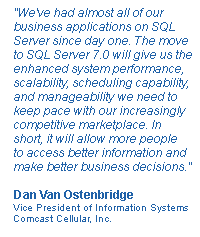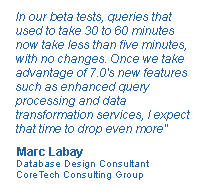
Through SQL Server 7.0, Comcast Cellular takes a quantum leap in system performance and scalability to keep pace with the increasingly competitive telecommunications industry. The cellular and wireless telecommunications business has virtually exploded over the past few years, with competitors introducing a profusion of new service plans, features, functions and pricing propositions. In this highly competitive landscape, the ability to quickly access, analyze, and respond to competitive information is a critical differentiating factor. To provide a scalable, enterprise solution for managing business information, Comcast Cellular, Inc. is upgrading all of its major business applications from Microsoft® SQL Server™ 6.5 to 7.0. One of the nation's largest non-wireline carriers, Comcast Cellular serves a population of over 8.4 million throughout Pennsylvania, New Jersey, and Delaware. "We've had almost all of our business applications on SQL Server since day one," explains Dan Van Ostenbridge, Vice President of Information Systems. "The move to SQL Server 7.0 will give us the enhanced system performance, scalability, scheduling capability, and manageability we need to keep pace with our increasingly competitive marketplace. In short, it will allow more people to access better information and make better business decisions." A quantum leap in accessibility "We're expecting SQL Server 7.0's new architecture to provide a quantum leap in accessibility for our financials," notes Dan. "We will be able to provide much more detailed and useful financial information and analysis to our management team as well as our parent company, and we've shortened our monthly close period by several days." Adds Dan, "The PeopleSoft and SQL Server 7.0 combination will also give our end users direct access to corporate information through user-oriented reporting and drill downs. This benefits our MIS department because it keeps them out of the report writing business. And it benefits our end users since they don't have to wait in a queue." Comcast's PeopleSoft applications include General Ledger,
Assets Management, Projects, Purchasing, Accounts Payable, Accounts During 1999, Comcast will upgrade its remaining business applications to SQL Server 7.0. The total database volume is 200 gigabytes, with peak transaction rates of 7000 per minute and average transaction rates of 3,360,000 per day. The database runs on 25 6000 Compaq servers with 512 MB RAM. Once the upgrade is completed, Comcast anticipates that its concurrent users will increase from 250 to 500, and that total users will increase from 1000 to 1500. Simplified administration Data mart solution contains costs To enable fast access to this information, Comcast began working with CoreTech Consulting Group in January of 1997 to design and develop a data mart that receives a daily extract of the call records data. Currently, there are two 40-gigabyte data marts receiving 500,000 wholesale call records per day. During 1999, the daily feed will be expanded to include retail information, for a total of 1.2 to 1.5 million records per day. "An important business benefit of the data mart is that it allows Comcast's financial analysts to quickly analyze rate charges used by the service bureau," explains Marc Labay, CoreTech's Principal Data Base Design Consultant. "In the past, it was difficult for the business units to confirm that correct billing rates were being used." At present, the data mart's 15 concurrent users perform queries against the database using Microsoft Access, then analyze the data in Access or take it into Microsoft Excel. In the future, Comcast plans to use SQL Server 7.0's OLAP Services and Microsoft PivotTable Service to enable adhoc queries directly through Excel. Comcast is already seeing positive results from migrating the data mart from SQL Server 6.5 to 7.0. "In our beta tests, queries that used to take 30 to 60 minutes now take less than five minutes, with no changes," notes Labay. "Once we take advantage of 7.0's new features such as enhanced query processing and data transformation services, I expect that time to drop even more." Because customer satisfaction is a key differentiating factor in the wireless marketplace, Comcast also maintains a 24x7 customer care application fed by two additional data marts. The application is supported by a front-end graphical system that allows customer service representatives to quickly access accounts and answer questions. The customer care application and databases, as well as Comcast's voice response system and a variety of automated retail products, are all fed by SQL Server databases. Comcast's operational data stores, in turn, feed sales, marketing, inventory, and billing information into a central sales data system and other reporting environments. The operational databases are 5 gigabytes in size while each data mart spans multiple servers and take up no more than 125 gigabyte of space. These servers are Compaq ProLiant 5000 and 6000 servers running Windows NT Server 4.0 and SQL Server 6.5. The upgrade to SQL Server 7.0 for this environment is planned for 1999. In 1996, Comcast considered moving from its data mart solution to a full data warehousing environment with a solution from NCR, Oracle, or Informix. Notes Dan, "We never got too far down the path because we realized that, with the expected evolution of SQL Server, we would reap many of the benefits without the challenge of moving to an entirely different technology skill set and without a significant additional investment." Continues Dan, "Because we already have expansive SQL Server data in our environment and are almost exclusively Microsoft BackOffice®-centered, staying with SQL Server allows us to move up the ladder of technology without having to make our database interoperable with a lot of other environments. We also avoid the expense of retraining our people, hiring multiple database administrators, and having maintenance contracts with multiple hardware and software vendors. Any time you can get a larger, more robust product via a natural migration, it's much better than integrating a new solution." Dan adds that another benefit from staying with SQL Server
is the ability to recruit and retain highly skilled people. "We're doing exciting
things with technology here, which has brought in some talented recruits," he says.
"Plus, staying with one technology makes succession planning and career progression
easier, since all my staff members can pursue the same technical skill set." "Whenever we've needed better, faster environments, SQL Server has been ready with the next release. To deliver the data our users need, SQL Server is far and away our best investment."
For more information about Microsoft products and
services, call the Microsoft Sales Information Center at (800) 426-9400. In Canada, call
the Microsoft Canada Information Center at (800) 563-9048. Outside the 50 United
States and Canada, please contact your local Microsoft subsidiary. To access information
via the World Wide Web, go to: © 1998 Microsoft Corporation. All rights reserved. This case study is for informational purposes only. MICROSOFT MAKES NO WARRANTIES, EXPRESS OR IMPLIED, IN THIS SUMMARY. Microsoft, BackOffice, PivotTable and Windows NT are either registered trademarks or trademarks of Microsoft Corporation in the United States and/or other countries. Other product and company names mentioned herein may be the trademarks of their respective owners. 10/98 [ About CoreTech ] [ Services ] [ News &
Events ] [ Employment ]
|
||||||

 Receivable, Billing, Inventory, and Order Management. Comcast also
uses PeopleSoft’s workflow functionality extensively in the purchasing process.
Purchase Orders are entered online, intelligently routed to the appropriate approver based
on dollar amount and department. The designated approver is notified via an email message
that a PO is awaiting their approval. Manager’s approve PO’s online and dispatch
them from their desktop. The entire process is paperless and very efficient. The
PeopleSoft database is currently 3 gigabytes in size. Users access PeopleSoft applications
via Compaq DeskPro 4000 PCs and Toshiba Tecra 550 Laptops.
Receivable, Billing, Inventory, and Order Management. Comcast also
uses PeopleSoft’s workflow functionality extensively in the purchasing process.
Purchase Orders are entered online, intelligently routed to the appropriate approver based
on dollar amount and department. The designated approver is notified via an email message
that a PO is awaiting their approval. Manager’s approve PO’s online and dispatch
them from their desktop. The entire process is paperless and very efficient. The
PeopleSoft database is currently 3 gigabytes in size. Users access PeopleSoft applications
via Compaq DeskPro 4000 PCs and Toshiba Tecra 550 Laptops.  means that call records data --
such as high-usage times and locations used to set pricing and develop special rate plans
-- is locked away in older technology.
means that call records data --
such as high-usage times and locations used to set pricing and develop special rate plans
-- is locked away in older technology.